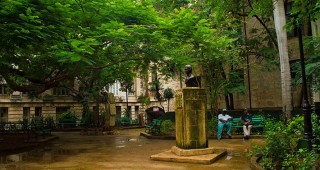Calle 23, or 23rd Steet, is a central, busy street in El Vedado district. It begins at the sea and ends in a river, the Almendares. Its first five streets, from Malecón to L Street are known as La Rampa, literally The Ramp, because it is on a slope. It is crossed by important avenues such as Avenida de los Presidentes and Paseo. Restaurants, ministries, movie theaters, mansions, churches, clubs, cigar factories are some of the sights found in this important thoroughfare.
Calle 23 stretches across Vedado from east to west, a defining artery in terms of character and geography. From the modern-day buzz and ’50s high-rises of La Rampa, Calle 23 soon enters a mixture of low-rise apartment buildings, parks and commercial areas along its central stretch. In a small park at 23 and J, Cervantes fans will find an unusual nude and skinny statue of Don Quixote, made by artist Sergio Ramírez of thin steel rods and bars in 1980, mounted on his rail-thin steed Rocinante. A few blocks further west is a reconstruction project under the City Historian’s Office: the future Casa Ambientada de Arquitectura y Mobiliaria (Calle 23 #664, 835-3398), between D and E, will contain exhibits on period architecture and furniture. The façade and interior show striking examples of elaborate moulded wall reliefs from the 1920’s, when the house was built. The opening is anticipated for November 2006.
Further west on 23, at the intersection with Calle 12, is Vedado’s second vibrating nerve centre (after 23 and L), with restaurants, cafés, peso shops, art galleries, cinemas and the headquarters of the Instituto Cubano del Arte e Industria Cinematográficos (ICAIC). Directly across the street from ICAIC is its Centro Cultural Cinematográfico, where there is a small café, art gallery and store (open 9am-5pm daily) that sells posters of Cuban films, videos and DVDs. Or you might want to visit Café Literario (open 9am-9pm daily), half a block to the west just past Calle 12, a charming little peso café that sells coffee and Cuban sweets, and has a modest stand of Spanish-language books (mainly poetry and literature) for clients to read or purchase.
One block south of 23, on Calle 12, is Zapata, where you’ll find the main entrance to the Cementerio Colón (see below), an extraordinary city of the dead on the southern limits of Vedado. Following Zapata west around the periphery of Colón to Calle 26 is the Cementerio Chino (see below). Following Zapata east to the intersection with Paseo is the often-missed Memorial a Ethel y Julius Rosenberg. Sculpted by Cuban artist José Delarra, it honours the American couple who died in the electric chair in Sing Sing prison, New York, in 1953, after being falsely accused of giving the Russians the secret of the atom bomb. Every year, on 19 June – the day of their execution –Cubans gather here for a modest remembrance ceremony.
Back on Calle 23, between 14 and 16, is the famous H.Upmann cigar factory (835 1371/2), which relocated here two years ago from Centro Habana. You’ll easily recognise it as it occupies a full block and is painted a soft yellow colour. Visits, including English-speaking guides, must be coordinated beforehand at Hotels Saratoga, Parque Central or Inglaterra, all in Habana Vieja. The quieter western end of 23 is a residential neighbourhood of large individual properties, which extends as far as Río Almendares, the boundary between Vedado and Miramar.






 Colonial
Colonial







